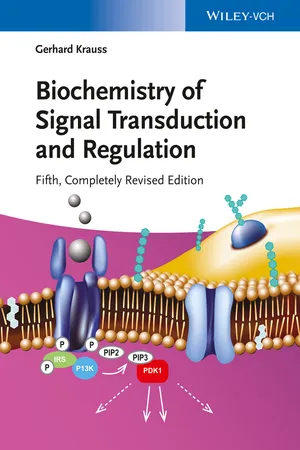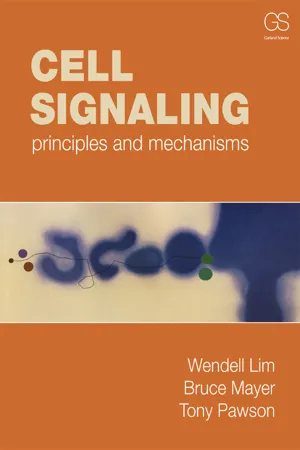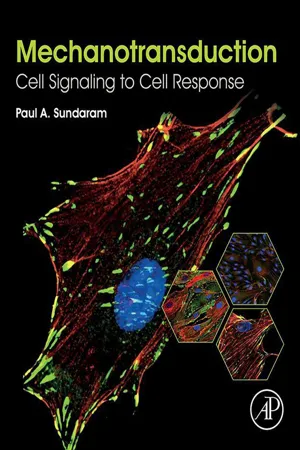Biological Sciences
Autocrine Signaling
Autocrine signaling is a type of cell communication in which a cell releases signaling molecules that bind to receptors on its own surface, leading to a response within the same cell. This self-stimulating process allows the cell to regulate its own activities, such as growth, differentiation, and immune response, without the need for external signals from neighboring cells.
Written by Perlego with AI-assistance
Related key terms
Related key terms
1 of 4
Related key terms
1 of 3
8 Key excerpts on "Autocrine Signaling"
- Gerhard Krauss(Author)
- 2014(Publication Date)
- Wiley-VCH(Publisher)
The hormone reaches the target cells from the hormone-producing cell by passive diffusion. The producing cell must be found in the vicinity of the receiving cells for this type of communication. The signaling is rather local, and the participating signaling molecules are sometimes termed tissue hormones or local mediators. One special case of paracrine signal transduction is that of synaptic neurotransmission, in which a nerve cell communicates with either another nerve cell or with a muscle cell. 1.3.3.3 Autocrine Signaling In Autocrine Signaling, cells of the same type communicate with one another. The hormone produced by the signaling cell affects a cell of the same type by binding to receptors on these cells, initiating an intracellular signal cascade. If an autocrine hormone is secreted simultaneously by many cells, then a strong response is triggered. Autocrine mechanisms are of particular importance in the immune response. 1.3.4 Direct Protein Modification by Signaling Molecules A special case of intercellular signaling is represented by a class of small, reactive signaling molecules, such as nitric oxide (NO; see Section 8.10). NO is synthesized in a cell in response to an external signal and is delivered to the extracellular fluid. NO reaches neighboring cells either by diffusion or in a protein-bound form, and a modification of the target enzymes ensues which results in a change in the activity of these enzymes. NO is characterized as a mediator that lacks a receptor in the classical sense. 1.4 Intracellular Signaling: Basics External signals such as hormones, sensory signals or electrical signals are specifically recognized by receptors that transduce the external signal into an intracellular signaling chain- Timir Tripathi, Vikash Kumar Dubey, Timir Tripathi, Vikash Kumar Dubey(Authors)
- 2022(Publication Date)
- Academic Press(Publisher)
143.2: Signaling via cell–cell direct contact or Juxtacrine signaling
Cellular communication also occurs through direct cell-to-cell contact where both the receptor and ligand are membrane-bound. It is also known as juxtacrine signaling and can occur through three mechanisms: cell-to-cell direct contact, gap junction-mediated signaling, and extracellular matrix (ECM)-mediated signaling. One of the most important examples of juxtacrine signaling is the notch-delta signaling pathway. Notch signaling is involved in stem cell fate maintenance and also cell differentiation by the lateral inhibition mechanism.15 Signaling involving the ECM-mediated crosstalk between integrins and actin cytoskeleton controls a wide array of vital cellular functions such as proliferation, migration, apoptosis, and differentiation.164: Cell signaling orchestrates key biological processes
Cells need to be in constant communication with neighboring cells and the extracellular environment to maintain internal homeostasis, grow, and divide. Signal transduction helps the cells internalize the external cues and carry out effector functions necessary for survival. Signaling controls virtually all the key biological processes of cells, i.e., cell growth, division, differentiation, energy metabolism, migration, and cell death. A signal transduction pathway can regulate one or more of these cellular functions. There are various modes of cell-to-cell communication, depending on the source of the signal received by the cells. Cells can receive messages carried by small molecules, peptides, or proteins secreted by other cells. Cells can also undergo direct physical contact with each other for signaling. They can also receive signals from the extracellular matrix (ECM), where the ECM relays information through mechanical stimuli or ECM-bound molecules. Physical factors, such as heat, light, electrical impulses, and mechanical forces, also activate specific signaling pathways. All these signals activate specific pathways that translate into a change in cell behavior and function. The various modes of signaling and the associated pathways are discussed in the next section.- eBook - ePub
- Marc J. Klowden(Author)
- 2013(Publication Date)
- Academic Press(Publisher)
The external signal is thus internalized, amplified, and distributed to several internal targets (Figure 1.1). The chemical signals may consist of many types of molecules, categorized by their range and speed of activity. After the signal is transduced and arrives inside the cell, its target might be either already-synthesized proteins that become activated by the message, or changes in gene expression, either of which can alter cell physiology and behavior (Figure 1.2). Figure 1.1 A signal molecule binds to specific receptor sites on the cell membrane. The activation of the receptor transduces the signal to the cell interior where it is amplified by parallel pathways and distributed to targets. Figure 1.2 Targets of signal transduction in the cell. Cell physiology, metabolism, or behavior may be modified by altered gene expression or altered protein function. Autocrine Signaling is the most private of the signaling modes, with a cell signaling itself by producing a chemical that activates receptors within its own cytoplasm or on its surface (Figure 1.3A). An example is the prothoracic gland, which during some developmental stages activates its own production of ecdysteroids. Figure 1.3 Types of cell signaling. A. Autocrine Signaling. B. Contact-dependent signaling. C. Neuronal signaling. D. Endocrine signaling. E. Paracrine signaling. See the text for an explanation. Contact-dependent signaling relies on direct contact between neighboring cells, with signaling molecules embedded in the cell membranes or passed directly through pores (Figure 1.3B). The signaling cell may produce a molecule that binds to a receptor in the adjacent target cell, or release ions that are transferred through gap junctions to trigger a response only in those cells that are in direct contact. Also called juxtacrine signaling, this is the fastest mode of communication and can be found in cardiac muscle cells whose contractions are coordinated, allowing these to occur simultaneously - No longer available |Learn more
- Mary Wuerth(Author)
- 2023(Publication Date)
- Barrons Educational Services(Publisher)
UNIT 4Cell Communication and Cell CyclePassage contains an image
10
Cell Communication and Signaling
Learning ObjectivesIn this chapter, you will learn:➜Types of Cell Signaling➜Signal Transduction➜Disruptions in Signal Transduction Pathways➜Feedback MechanismsOverview
Biological systems interact, exchange information about their environments, and respond to this information. Life often depends on responding quickly to changing environmental conditions. This chapter reviews the basics of cell communication and the process of signal transduction.Types of Cell Signaling
The survival of a living organism depends on the ability of its cell, or cells, to communicate by sending, receiving, and responding to chemical signals. These chemical signals are called ligands. Figures 10.1–10.4 show four general types of cell signaling:1.Autocrine Signaling—In Autocrine Signaling, the cell secretes a ligand. This ligand then binds to a receptor on the cell that secreted the ligand, triggering a response within that same cell. The root word auto means “self,” so this process can be thought of as a cell signaling itself to generate a response. An example of this is a cancer cell, which releases its own growth hormones (the ligands) that stimulate the cancer cell to grow and divide.Figure 10.1 Autocrine Signaling2.Juxtacrine signaling—This is signaling that depends on direct contact between the cell that is sending the ligand and the cell that is receiving and responding to it via a surface receptor. Examples of juxtacrine signaling include plasmodesmata in plants (which involve the ligand traveling between channels that connect adjacent cells) and antigen-presenting cells in the human immune system (which signal helper T cells through direct cell-to-cell contact).Figure 10.2 Juxtacrine Signaling3.Paracrine signaling - eBook - ePub
- Wendell Lim, Bruce Mayer, Tony Pawson(Authors)
- 2014(Publication Date)
- Garland Science(Publisher)
Figure 1.3 ). Indeed, the diversity of areas of inquiry that ultimately led to the field of cell signaling underlines the central role of signaling across biology. For example, because signaling is so important to normal physiology, the disruption or misregulation of signaling mechanisms is the basis for many human diseases, and thus these mechanisms are of interest in the areas of medicine and human health. Similarly, because normal development depends on the precise coordination of cell behaviors such as differentiation and movement, research on developmental events necessarily sheds light on the underlying signaling mechanisms. And because the signaling apparatus is comprised of biomolecules such as proteins, which are encoded by the genetic material, signaling mechanisms are amenable to the experimental approaches and analytic tools of biochemistry and geneticsFigure1.3Many different fields of research contributed to the current understanding of cell signaling. Research in a wide variety of different disciplines revealed a common set of mechanisms and pathways that provide the basis for diverse biological activities.Cancer biology played a particularly important role in the emergence of the field of cell signaling. Our understanding of the molecular basis of cancer was revolutionized by the discovery of oncogenes, genes that when mutated or overexpressed induce cells to respond inappropriately to normal signals and therefore proliferate uncontrollably, potentially leading to the formation of a malignant tumor (cancer). These oncogenes, once cloned and biochemically characterized, were in most cases found to be constitutively active or otherwise misregulated forms of signaling proteins. By understanding how signaling mistakes could lead to cancer, we learned a great deal about the normal signaling mechanisms that regulate cell proliferation and differentiation.The field of endocrinology focuses on how hormones secreted into the blood, such as insulin, coordinate physiological communication between the different organs and glands that comprise an organism. As researchers delved into the biochemical basis by which target cells respond to hormones, a similar group of signaling molecules to those found in cancer biology was uncovered. For example, the receptor for insulin, because of its enormous significance to the common human disease diabetes, was one of the first hormone receptors to be cloned. The fact that it was highly related to some of the oncogenic proteins that cause cancer, and had the same biochemical activity (the ability to phosphorylate tyrosine residues on its target substrates), underscored the commonality of signaling mechanisms. - eBook - ePub
Volatile Biomarkers for Human Health
From Nature to Artificial Senses
- Hossam Haick, Hossam Haick(Authors)
- 2022(Publication Date)
- Royal Society of Chemistry(Publisher)
Part 2: Communication: Volatile Biomarkers as a Signaling AgentsPassage contains an image Chapter 9 Signal Transfer and Transduction between Cells
Mamatha Serasanambatia , Dina Hashoul,b and Hossam Haick,ba a Department of Medicine, Washington University in St. Louis, St. Louis, MO 63110, USA;b Department of Chemical Engineering and Russell Berrie Nanotechnology Institute, Technion – Israel Institute of Technology, Haifa 3200003, IsraelEmail: [email protected]9.1 Introduction
Cell-to-cell communication has a critical role during tumor development and progression, allowing cancer cells to reprogram the surrounding tumor microenvironment and cells located at distant sites.1 ,2Cells communicate by several means, nonetheless, with broadly three types of cell communication: autocrine, paracrine and juxtacrine signaling.3 In Autocrine Signaling, a cell secretes a chemical messenger and has the cognate receptor, thereby allowing it to communicate with itself and other cells of the same type. Paracrine signaling involves at least two types of cells: one cell type without the cognate receptor secretes a chemical message, whereas another cell type has the cognate receptor but does not secrete the biomolecule. Lastly, juxtacrine signaling involves two cells in which one cell has a membrane-bound ligand that binds to its cognate receptor on another cell.2 –5Proteomic and genomic approaches have been the main approaches to study signaling communication in cell proliferation, migration, cell recognition and differentiation.6 Though tremendous advances have been achieved, several limitations restrict the fulfilment of approaches to diagnosis and therapeutic applications. These limitations include but are not confined to:5 –9(1) proteomics and genomics requiring prior and accurate knowledge of specific genes or proteins, exclusive to in vitro and in vivo trials – something that does not necessarily reflect real-life situations; and (2) genomics and proteomics, which continue to be expensive and of low specificity and which require complex analytical algorithms that are prolonged and cumbersome. Since cancer is a systematic disease (polygenetic) that involves several mutations at different sites8 (genetic, epigenetic, local to or at a distance from the primary tumor, etc. - eBook - ePub
Mechanotransduction
Cell Signaling to Cell Response
- Paul A. Sundaram(Author)
- 2020(Publication Date)
- Academic Press(Publisher)
The distance effect on cell signaling is summarized in Fig. 2.2. Figure 2.2 Cell communication methods. (A) Autocrine Signaling illustrating the release of ligands by a cell to be received by its own receptor and accomplish the physiological function of the cell. (B) During direct contact signaling, the cells are in contact with each other where the effector cell secretes the required chemical signal into the target cell. (C) Paracrine signaling, indicating close proximity of effector and target cells where ligands from the effector cells are released for binding with receptors in the target cells. (D) Endocrine signaling, where the effector and target cells are at a considerable distance from each other, and the ligand is transported long distances to elicit a response from the target cell. 2.3 Phases in cell signaling The cell signaling process can be divided into three distinct phases, which occur in the following order, reception, transduction, and response. This means that transduction cannot take place before reception and neither can response occur before signal reception and transduction. 2.3.1 Reception Cell signaling is normally initiated when a small molecule or even a larger protein is released by one set of cells to trigger a response. This initiator signal, commonly called a ligand, attaches to a cell receptor, as seen in Fig. 2.3. This signaling molecule is sometimes called a first messenger. The receptor is responsible for receiving the signal and is normally a transmembranal protein. This phase of cell communication is called reception. Fig. 2.3 further illustrates that only a specific ligand can attach to a specific receptor to activate it. The analogy is similar to a lock and key. Only a specific key (ligand) can open a particular lock (receptor) under normal operating conditions and the ligand attaches to a specific binding site on the receptor to activate it - eBook - ePub
- Sayali Mukherjee, Somali Sanyal, Sonia Chadha, Sayali Mukherjee, Somali Sanyal, Sonia Chadha(Authors)
- 2018(Publication Date)
- Apple Academic Press(Publisher)
Both inter and intracellular communication is important for proper functioning of individual cells and coordination with nearby cells, which is dependent upon the potential of some cells to emit signals and for other cells to respond to the received signals accordingly. Normal cells need stimulatory signals for proliferation and differentiation, which is facilitated by transmembrane receptors present on the cell surface to which extracellular matrix (ECM) components, cell-cell adhesion molecules, and growth factors can bind and induce the cascade of reaction. Unlike normal cells, cancer cells contrast strongly by showing reduced dependence on exogenous growth-promoting and growth-inhibitory factors, evading processes like apoptosis and senescence and thereby evading mechanisms that limit cell proliferation. In addition to this, cancer cells can also switch the integrin receptors, and successful binding of these receptors with ECM enables them to transduce signals into the cytoplasm, which can influence cells by altering its motility, apoptosis, etc. These properties of cancer cells can lead to deregulation of many signaling pathways. Many of these signaling proteins are currently under investigation as possible targets for cancer therapy. The present chapter deals with the various signaling pathways involved in cancer and the complexity of signal transduction that involves the cross-talk of several factors and very few unifying principles.7.1 IntroductionCancer can be defined as a program that promotes uncontrolled proliferation of cells. This abnormal cellular behavior might lead us to assume that cancer cells employ alternative and novel cellular signaling strategy to feed their unrestrained growth and division. But the reality is that there are subtle differences between normal and tumor cell intracellular signaling and the later actually utilizes an almost identical control circuitry. The major difference lies in the way the tumor cells modulate the existing signaling program and bend it in their own way. Cellular signaling pathways, in general, are not isolated from each other but are inter-connected to form complex networks. Cells receive information from various sources via receptors, cell-matrix, and cell-cell contacts, which is then integrated and utilized to regulate varied cellular processes, including protein synthesis, cell growth, motility, cell architecture, polarity, differentiation, and programmed cell death. Interestingly, a single signaling molecule can act in a context-dependent manner and regulate different cellular processes with multiple signaling complexes or at different intracellular locations. The intricacy of the cellular signaling networks has major implications toward our understanding of cancer cell behavior and for our ability to use this knowledge for cancer therapy. We are gradually unraveling the intricate network of signaling and the nodes and extent of crosstalk between various molecules in the tumor cells. The present chapter described this complex signaling circuitry functional in the cellular environment of cancer cells that fuel their growth and proliferation.
Index pages curate the most relevant extracts from our library of academic textbooks. They’ve been created using an in-house natural language model (NLM), each adding context and meaning to key research topics.
Explore more topic indexes
Explore more topic indexes
1 of 6
Explore more topic indexes
1 of 4







